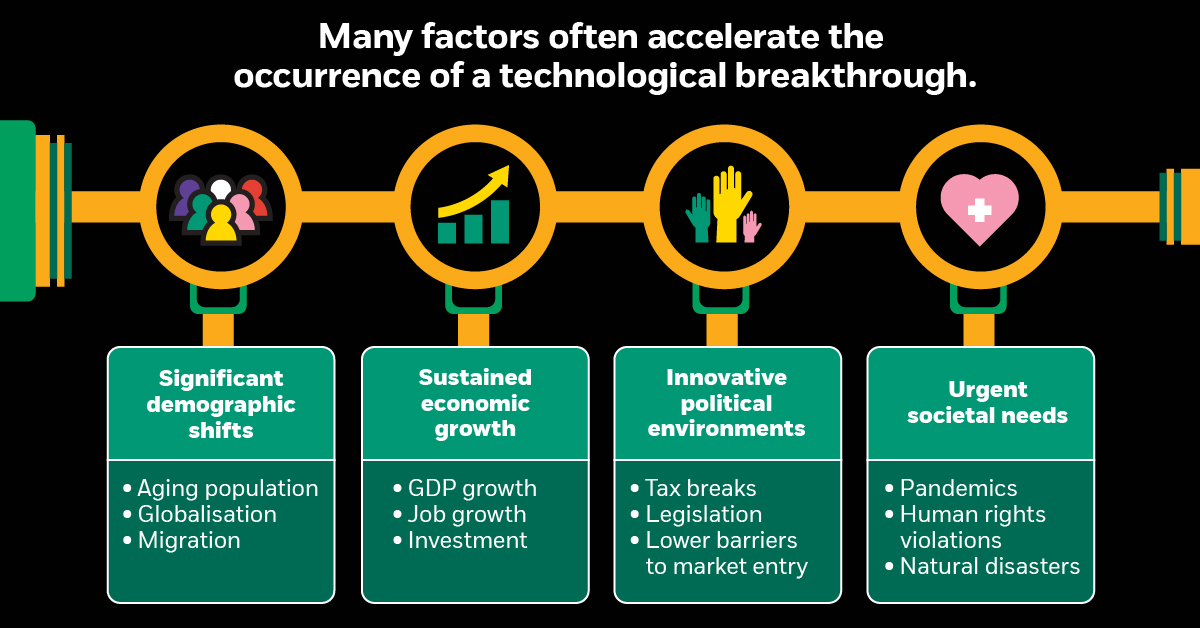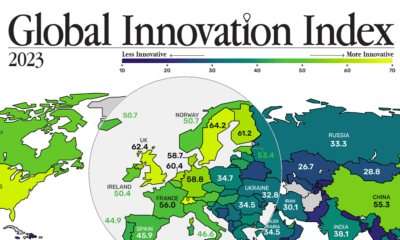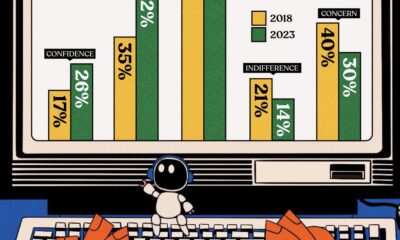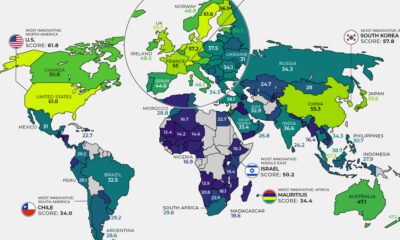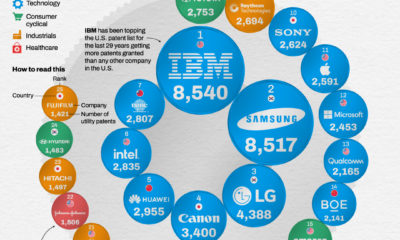Technology
An Investing Megatrend: How Technological Breakthroughs are Shaping the Future
Since Apple released the first iPhone in 2007, few industries have been left unaffected.
This transformational device is a prototypical example of a technological breakthrough. It was a tipping point in turning entire business models upside-down, while also impacting our everyday lives at a more fundamental level.
New growth opportunities emerged from the ensuing disruption, while many status quo solutions were rendered obsolete.
Technological Game-Changers
Today’s infographic from BlackRock highlights the pervasive and positive impact that technological breakthroughs can have on the global economy.

Fueling the Flames of Innovation
According to recent data from Accenture, it’s estimated that 71% of businesses are on the brink of being disrupted.
In fact, disruptive innovation most often emerges in two scenarios:
- New solutions to existing problems or challenges that have proven difficult to solve
- New competitors in highly profitable sectors with historically high returns
The occurrence of technological breakthroughs can also be accelerated through several factors, including significant demographic shifts, sustained economic growth, innovative political environments, and urgent societal needs.
Technological Adoption is Speeding Up
Breakthrough inventions have always sent ripple effects throughout society, but today those ripples are travelling faster than ever.
Moore’s Law – the assertion that number of components in a dense integrated circuit (i.e., transistors, resistors, diodes, or capacitors) will double every year, while still getting cheaper – is one factor. Similar examples of staggering increases in utility for less cost can be found in a number of other instances, from DNA sequencing to data storage.
The rate of technological adoption is also speeding up. For example, consider the mobile phone─due to the price point and ease of use, the number of U.S. adults with a cell phone jumped from 10% in 1994 to over 96% in 2019. This is also evident in new technologies such as smart speakers, where the adoption rate in the U.S. is expected to double to 55% in less than 3 years.
Breakthrough Investment Opportunities
Where innovation leads, investment usually follows. However, predicting which technological innovations will have a lasting impact on society has often proved difficult.
Instead, investors can track the wider trends that often spark technological disruption, in order to unlock potential opportunities:
- Research and Development Funding:
The number of investments in emerging technologies is growing. Tech company acquisitions also totalled US$278 billion by Q2 2018—a 50% increase from the year before. - The Future Workforce:
Historically, productivity gains have increased the demand for more skilled labour. Technical and soft skills are top priorities for employers for their future teams, and it it’s projected that the amount of hours that workers spend using technological skills will increase by 55% from 2016 to 2030. - Shifts in Consumer Demand:
Companies aware of these factors should seek to incorporate innovations into their platforms for a more customer-centric experience. - Societal Needs:
Persistent global social issues such as access to better healthcare are drivers of innovative solutions that offer a better quality of life. Symphony Post-Acute Network harnessed artificial intelligence (AI) and machine learning (ML) to be able to offer personalised healthcare for over 80,000 patients─cutting costs by more than US$13,000 per patient.
Future Impact of Technological Innovation
Technological change will likely continue to accelerate, and investors should tailor their portfolios accordingly.
At the same time, traditional barriers to entry for new competitors are consistently being eroded by these breakthroughs, sending industries into flux and creating potential new opportunities.
Humanity’s co-evolution with technology will continue to profoundly impact the economy, while improving life on Earth in unimaginable ways.
Brands
How Tech Logos Have Evolved Over Time
From complete overhauls to more subtle tweaks, these tech logos have had quite a journey. Featuring: Google, Apple, and more.

How Tech Logos Have Evolved Over Time
This was originally posted on our Voronoi app. Download the app for free on iOS or Android and discover incredible data-driven charts from a variety of trusted sources.
One would be hard-pressed to find a company that has never changed its logo. Granted, some brands—like Rolex, IBM, and Coca-Cola—tend to just have more minimalistic updates. But other companies undergo an entire identity change, thus necessitating a full overhaul.
In this graphic, we visualized the evolution of prominent tech companies’ logos over time. All of these brands ranked highly in a Q1 2024 YouGov study of America’s most famous tech brands. The logo changes are sourced from 1000logos.net.
How Many Times Has Google Changed Its Logo?
Google and Facebook share a 98% fame rating according to YouGov. But while Facebook’s rise was captured in The Social Network (2010), Google’s history tends to be a little less lionized in popular culture.
For example, Google was initially called “Backrub” because it analyzed “back links” to understand how important a website was. Since its founding, Google has undergone eight logo changes, finally settling on its current one in 2015.
| Company | Number of Logo Changes |
|---|---|
| 8 | |
| HP | 8 |
| Amazon | 6 |
| Microsoft | 6 |
| Samsung | 6 |
| Apple | 5* |
Note: *Includes color changes. Source: 1000Logos.net
Another fun origin story is Microsoft, which started off as Traf-O-Data, a traffic counter reading company that generated reports for traffic engineers. By 1975, the company was renamed. But it wasn’t until 2012 that Microsoft put the iconic Windows logo—still the most popular desktop operating system—alongside its name.
And then there’s Samsung, which started as a grocery trading store in 1938. Its pivot to electronics started in the 1970s with black and white television sets. For 55 years, the company kept some form of stars from its first logo, until 1993, when the iconic encircled blue Samsung logo debuted.
Finally, Apple’s first logo in 1976 featured Isaac Newton reading under a tree—moments before an apple fell on his head. Two years later, the iconic bitten apple logo would be designed at Steve Jobs’ behest, and it would take another two decades for it to go monochrome.
-

 Markets1 week ago
Markets1 week agoRanked: The Largest U.S. Corporations by Number of Employees
-

 Green3 weeks ago
Green3 weeks agoRanked: Top Countries by Total Forest Loss Since 2001
-

 Money2 weeks ago
Money2 weeks agoWhere Does One U.S. Tax Dollar Go?
-

 Automotive2 weeks ago
Automotive2 weeks agoAlmost Every EV Stock is Down After Q1 2024
-

 AI2 weeks ago
AI2 weeks agoThe Stock Performance of U.S. Chipmakers So Far in 2024
-

 Markets2 weeks ago
Markets2 weeks agoCharted: Big Four Market Share by S&P 500 Audits
-

 Real Estate2 weeks ago
Real Estate2 weeks agoRanked: The Most Valuable Housing Markets in America
-

 Money2 weeks ago
Money2 weeks agoWhich States Have the Highest Minimum Wage in America?

